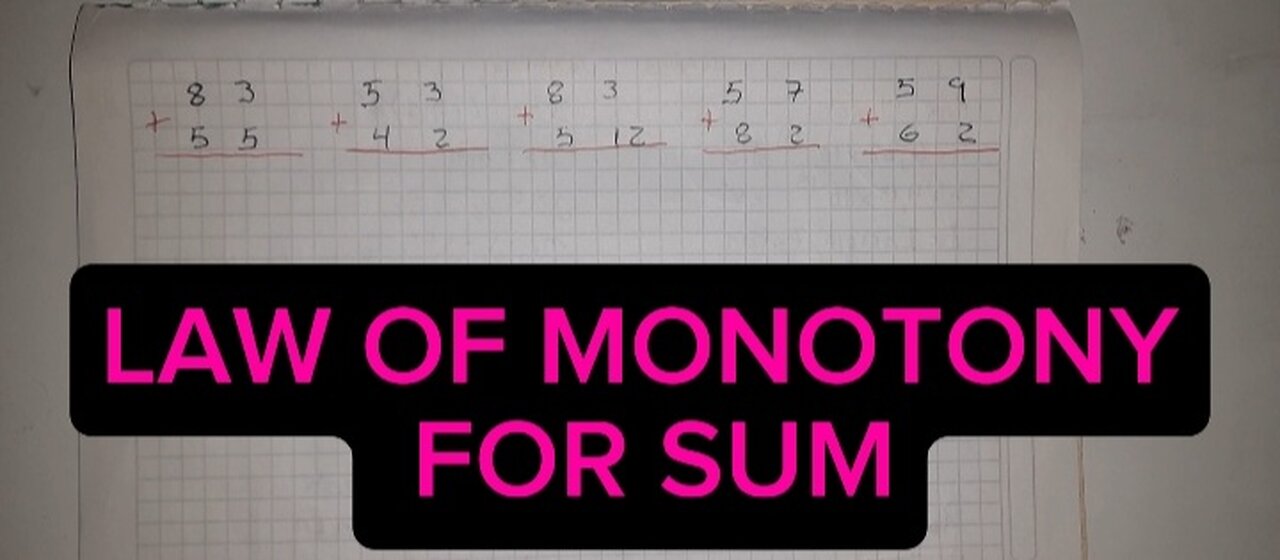Premium Only Content

LAW OF MONOTONY FOR SUM: application exercises
The Law of Monotony for Addition states that if two quantities that vary monotonically (i.e., always increase or always decrease) in the same direction are added, the sum will also vary monotonically in that direction.
formal statement
If f(x) and g(x) are functions that vary monotonically in the same direction (both increasing or both decreasing) on an interval [a, b], then the function h(x) = f(x) + g (x) will also vary monotonically in the same direction in the interval [a, b].
Properties
1. If f(x) and g(x) are increasing, then h(x) = f(x) + g(x) is also increasing.
2. If f(x) and g(x) are decreasing, then h(x) = f(x) + g(x) is also decreasing.
Examples
1. If f(x) = x^2 and g(x) = 2x are increasing on the interval [0, ∞), then h(x) = x^2 + 2x is also increasing on that interval.
2. If f(x) = -x and g(x) = -2x are decreasing on the interval [0, ∞), then h(x) = -x - 2x = -3x is also decreasing on that interval.
Applications
The Law of Monotony for Addition is used in various areas, such as:
1. Mathematical analysis: to study the monotony of functions and its relationship with sum.
2. Optimization: to find the maximum or minimum of a function that is the sum of monotone functions.
3. Economics: to analyze the monotony of utility functions and its relationship with the sum of goods and services.
-
 LIVE
LIVE
EricJohnPizzaArtist
4 days agoAwesome Sauce PIZZA ART LIVE Ep. #70: Movie Night featuring Dark Helmet!
216 watching -
 LIVE
LIVE
Joker Effect
22 minutes agoMASSIVE UPDATES ON MY CHANNEL... what does 2026 look like? CHATTIN WITH WVAGABOND (The Captain).
316 watching -
 2:24:34
2:24:34
vivafrei
11 hours agoEp. 292: Bondi's Betrayal & Comey Judge Caught Lying! Crooks Acted Alone? Judicia Activism & MORE!
155K93 -
 LIVE
LIVE
GritsGG
5 hours ago#1 Most Warzone Wins 4015+!
1,009 watching -
 LIVE
LIVE
Due Dissidence
8 hours agoTrump SMITTEN By Mamdani, MTG RESIGNS, Hurwitz DOUBLES DOWN on CENSORSHIP, RFK Jr "Poetry" EXPOSED
1,308 watching -
 39:40
39:40
Tactical Advisor
5 hours agoUnboxing New Tactical Packs | Vault Room Live Stream 046
56.1K6 -
 3:30:58
3:30:58
elwolfpr
3 hours agoElWolfPRX Enters the Storm: First Winds
6.68K -
 14:59
14:59
MetatronHistory
19 hours agoAncient Bronze Was Not the Way You Think
30.3K9 -
 LIVE
LIVE
Misfit Electronic Gaming
5 hours ago $0.44 earned"LIVE" WolfPack hunting "ARC RAIDERS" Come Hang out with me.
64 watching -
 5:36:21
5:36:21
DeadMomAlive
8 hours agoSuper Hero Sundays Wonder Woman! BIRTHDAY WEEK!!!!!
22.9K2